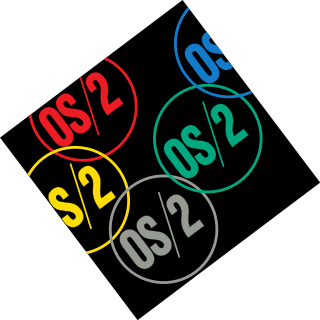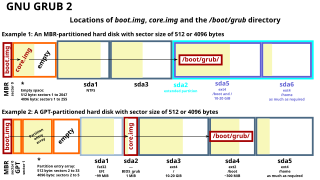Related Research Articles

In computing, BIOS is firmware used to provide runtime services for operating systems and programs and to perform hardware initialization during the booting process. The BIOS firmware comes pre-installed on an IBM PC or IBM PC compatible's system board and exists in some UEFI-based systems to maintain compatibility with operating systems that do not support UEFI native operation. The name originates from the Basic Input/Output System used in the CP/M operating system in 1975. The BIOS originally proprietary to the IBM PC has been reverse engineered by some companies looking to create compatible systems. The interface of that original system serves as a de facto standard.

A computer worm is a standalone malware computer program that replicates itself in order to spread to other computers. It often uses a computer network to spread itself, relying on security failures on the target computer to access it. It will use this machine as a host to scan and infect other computers. When these new worm-invaded computers are controlled, the worm will continue to scan and infect other computers using these computers as hosts, and this behaviour will continue. Computer worms use recursive methods to copy themselves without host programs and distribute themselves based on exploiting the advantages of exponential growth, thus controlling and infecting more and more computers in a short time. Worms almost always cause at least some harm to the network, even if only by consuming bandwidth, whereas viruses almost always corrupt or modify files on a targeted computer.
Malware is any software intentionally designed to cause disruption to a computer, server, client, or computer network, leak private information, gain unauthorized access to information or systems, deprive access to information, or which unknowingly interferes with the user's computer security and privacy. Researchers tend to classify malware into one or more sub-types.

OS/2 is a series of computer operating systems, initially created by Microsoft and IBM under the leadership of IBM software designer Ed Iacobucci. As a result of a feud between the two companies over how to position OS/2 relative to Microsoft's new Windows 3.1 operating environment, the two companies severed the relationship in 1992 and OS/2 development fell to IBM exclusively. The name stands for "Operating System/2", because it was introduced as part of the same generation change release as IBM's "Personal System/2 (PS/2)" line of second-generation personal computers. The first version of OS/2 was initially released in December 1987, and newer versions were released until December 2001.

This timeline of computer viruses and worms presents a chronological timeline of noteworthy computer viruses, computer worms, Trojan horses, similar malware, related research and events.

A boot sector is the sector of a persistent data storage device which contains machine code to be loaded into random-access memory (RAM) and then executed by a computer system's built-in firmware.
In computing, polymorphic code is code that uses a polymorphic engine to mutate while keeping the original algorithm intact - that is, the code changes itself every time it runs, but the function of the code stays the same. For example, the simple math expressions 3+1 and 6-2 both achieve the same result, yet run with different machine code in a CPU. This technique is sometimes used by computer viruses, shellcodes and computer worms to hide their presence.

Antivirus software, also known as anti-malware, is a computer program used to prevent, detect, and remove malware.

CIH, also known as Chernobyl or Spacefiller, is a Microsoft Windows 9x computer virus that first emerged in 1998. Its payload is highly destructive to vulnerable systems, overwriting critical information on infected system drives and, in some cases, destroying the system BIOS. The virus was created by Chen Ing-hau, a student at Tatung University in Taiwan. It was believed to have infected sixty million computers internationally, resulting in an estimated NT$1 billion (US$35,801,231.56) in commercial damages.
Linux malware includes viruses, Trojans, worms and other types of malware that affect the Linux family of operating systems. Linux, Unix and other Unix-like computer operating systems are generally regarded as very well-protected against, but not immune to, computer viruses.

Scareware is a form of malware which uses social engineering to cause shock, anxiety, or the perception of a threat in order to manipulate users into buying unwanted software. Scareware is part of a class of malicious software that includes rogue security software, ransomware and other scam software that tricks users into believing their computer is infected with a virus, then suggests that they download and pay for fake antivirus software to remove it. Usually the virus is fictional and the software is non-functional or malware itself. According to the Anti-Phishing Working Group, the number of scareware packages in circulation rose from 2,850 to 9,287 in the second half of 2008. In the first half of 2009, the APWG identified a 585% increase in scareware programs.
Jerusalem is a logic bomb DOS virus first detected at Hebrew University of Jerusalem, in October 1987. On infection, the Jerusalem virus becomes memory resident, and then infects every executable file run, except for COMMAND.COM. COM files grow by 1,813 bytes when infected by Jerusalem and are not re-infected. Executable files grow by 1,808 to 1,823 bytes each time they are infected, and are then re-infected each time the files are loaded until they are too large to load into memory. Some .EXE files are infected but do not grow because several overlays follow the genuine .EXE file in the same file. Sometimes .EXE files are incorrectly infected, causing the program to fail to run as soon as it is executed.

Stoned is a boot sector computer virus created in 1987. It is one of the first viruses and is thought to have been written by a student in Wellington, New Zealand. By 1989 it had spread widely in New Zealand and Australia, and variants became very common worldwide in the early 1990s.
Christmas Tree EXEC was the first widely disruptive computer worm, which paralyzed several international computer networks in December 1987. The virus ran on the IBM VM/CMS operating system.
A zero-day is a vulnerability or security hole in a computer system unknown to its owners, developers or anyone capable of mitigating it. Until the vulnerability is remedied, threat actors can exploit it in a zero-day exploit, or zero-day attack.

A computer virus is a type of malware that, when executed, replicates itself by modifying other computer programs and inserting its own code into those programs. If this replication succeeds, the affected areas are then said to be "infected" with a computer virus, a metaphor derived from biological viruses.

Bernd Fix is a German hacker and computer security expert.
Duqu is a collection of computer malware discovered on 1 September 2011, thought by Kaspersky Labs to be related to the Stuxnet worm and to have been created by Unit 8200. Duqu has exploited Microsoft Windows's zero-day vulnerability. The Laboratory of Cryptography and System Security of the Budapest University of Technology and Economics in Hungary discovered the threat, analysed the malware, and wrote a 60-page report naming the threat Duqu. Duqu got its name from the prefix "~DQ" it gives to the names of files it creates.
Sality is the classification for a family of malicious software (malware), which infects Microsoft Windows systems files. Sality was first discovered in 2003 and has advanced to become a dynamic, enduring and full-featured form of malicious code. Systems infected with Sality may communicate over a peer-to-peer (P2P) network to form a botnet to relay spam, proxying of communications, exfiltrating sensitive data, compromising web servers and/or coordinating distributed computing tasks to process intensive tasks. Since 2010, certain variants of Sality have also incorporated rootkit functions as part of an ongoing evolution of the malware family. Because of its continued development and capabilities, Sality is considered one of the most complex and formidable forms of malware to date.
TeslaCrypt was a ransomware trojan. It is now defunct, and its master key was released by the developers.
References
- ↑ "Threat Assessment of Malicious Code and Human Threats," History of Viruses, National Institute of Standards and Technology, Computer Security Division, internal report.
- ↑ "IBM's PC "Virus Timeline,"". research.ibm.com. Archived from the original on 27 October 2012.IBM research report.
- ↑ McAfee Labs Threat Center, Details and results of V2PX virus analysis.
- ↑ "Patricia Hoffman's VSUM Virus Information Summary List," V2P6 virus.
- ↑ "1260 (computer virus)," article.